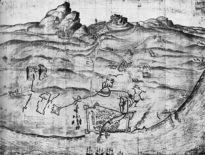On this day in Tudor history, 6th May 1471, Edmund Beaufort was executed at Tewkesbury following the Lancastrian defeat at the Battle of Tewkesbury during the Wars of the Roses.
How did he come to be executed when he was in sanctuary, and why was this the end of the Beaufort line?
What did this mean for the Lancastrians?
Find out in this #TudorHistoryShorts video...
On this day in Tudor history, 6th May 1502, in the reign of King Henry VII, Sir James Tyrell, former royal councillor, was executed for treason due to his links to a known traitor.
But it's not for his time as a trusted councillor, or for his links to a claimant to the throne that he is known, but for his alleged involvement in the murders of the Princes in the Tower.
Find out more in this video...
On this day in Tudor history, 6th May 1541, King Henry VIII issued an injunction ordering the Great Bible to be available in every church in England.
But what was this Bible?
Who had worked on its translation?
Find out...
A letter said to have been found amongst Thomas Cromwell's papers was written on this day in 1536, 6th May, and was given the title "To the King from the Lady in the Tower".
What did it say and was it written by Queen Anne Boleyn?



Edward iv stormed into the Abbey at Tewkesbury only to be confronted by the Abbot and eventually the refugees were handed over. A Court Martial was opened under the 18 year-old Richard, Duke of Gloucester, who as Lord High Constable and Marshall of England in place of Edward’s hitman, Robert Topcliffe, who was executed during the restoration of Henry vi. The last Beaufort males and others were tried, found guilty and beheaded. The Market Cross is the nearest spot to the execution place. Some commentators love to dramatically show the men being dragged out, but their surrender and arrest was negotiated and they were handed over as no refuge can be given to traitors. Sanctuary laws actually differed from place to place and Tewkesbury it is often argued that the Abbey didn’t have the authority or same privilege to protect all who sought Sanctuary and that Edward had legal power to demand those leaders who had fought against him be handed over. Others believe he simply bossed his way in and the Abbot, brave though he was standing up to the 6.4 foot King Edward, agreed to hand the Beaufort men over to keep the peace. Either way, they were handed over and Edward left the judgement to his brother, whose job it was, given his official position, who condemned them to death and Edward and John were beheaded.
That wasn’t the end of the story. Edward, Prince of Wales was fighting at Tewkesbury aged 17 and was killed. One source says he was taken prisoner and killed, but the most trustworthy and Croyland show he was killed in the route or the battle. A few weeks later, under mysterious circumstances, Henry vi died. Again there are two causes of death, murder by unknown means or death from melancholic displeasure. Nor can we confirm he died on 21st May as other dates have been given up to 26th May. Those who favour the murder story blame Richard, Duke of Gloucester who was among those at the Tower that night. It is debatable as to whether he carried the order from King Edward, highly likely, as his position would also have made this likely. If not, then he may have chosen the person to carry out this murder. Either way it was Edward iv who gave the order in order to obliterate the last Lancastrian male line. He had lost the throne once and by luck come back. Edward wasn’t going to risk losing it again and Henry was himself growing older and was himself tired of the burden of Kingship. It was as much a mercy killing as anything else.
Now there is still the claim in the Arrival of King Edward iv that Henry died of melancholic displeasure. This isn’t impossible. Henry vi had long term psychological and mental health problems. It was possible that the loss of everything, his wife taken prisoner, his kingdom lost, his only child lost, his own ill health etc left him unable to carry on. Such things causing people to become ill and die are not unknown today. People do give up and its not impossible that Henry Vi also gave up. However, there’s an odd post script. His body was put on public display before his funeral and it looked as if his skull had bled and some witnesses said it did so again. So we can either take this to show he had suffered a violent death or we can dismiss it or we can wonder at another explanation. Without a serious examination of the body of Henry vi we will never know for certain.
There is a ceremony held every year by the Society of the Lilies and the Rose in the Tower to commemorate King Henry Vi on May 21st. He was reburied in Saint George’s Chapel in Windsor in 1484 by King Richard iii.